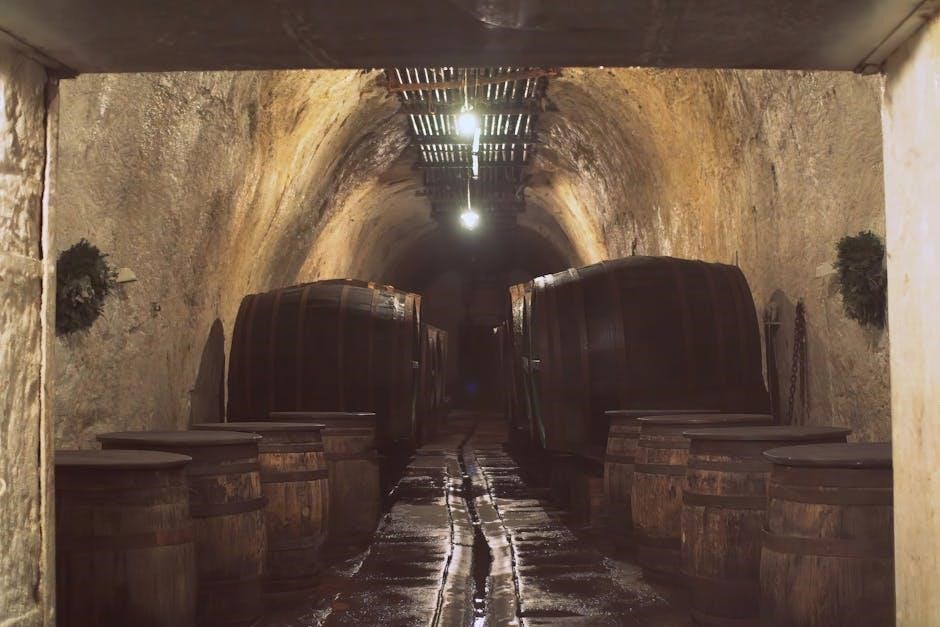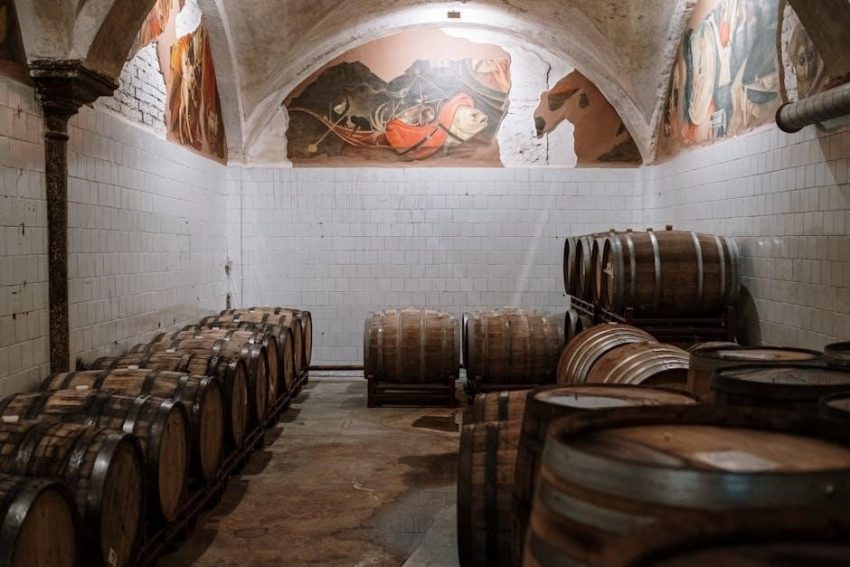The Cask of Amontillado is a chilling tale by Edgar Allan Poe, first published in 1846, exploring themes of revenge, deception, and pride through a dark narrative;
1.1. Overview of the Short Story
The Cask of Amontillado is a gripping tale of revenge and betrayal set in an unnamed Italian city during a festive season. Montresor, the narrator, seeks vengeance against Fortunato, a fellow nobleman, for perceived insults. Luring Fortunato into the family catacombs with the promise of a rare Amontillado wine, Montresor leads him deeper into the tunnels. Trapped and chained, Fortunato realizes his fate too late. The story masterfully builds suspense, exploring themes of pride, deception, and the darker aspects of human nature.
1.2. Historical Context and Publication
The Cask of Amontillado was first published in 1846 in Godey’s Lady’s Book, a prominent literary magazine of the time. Written during the height of American Romanticism, the story reflects Poe’s mastery of the Gothic genre. Its release coincided with a growing interest in dark, psychological narratives, cementing Poe’s reputation as a pioneer of horror and suspense. The tale’s themes of revenge and betrayal resonated with readers, making it one of Poe’s most enduring works.
1.3. Significance in Edgar Allan Poe’s Works
The Cask of Amontillado stands as a cornerstone of Poe’s literary legacy, exemplifying his mastery of psychological depth and atmospheric horror. Its exploration of revenge, pride, and deception aligns with recurring themes in his works, such as The Tell-Tale Heart and The Fall of the House of Usher. The story’s intricate narrative structure and use of symbolism showcase Poe’s innovative storytelling, solidifying its place as one of his most analyzed and celebrated tales in American literature.

Themes in “The Cask of Amontillado”
The story masterfully explores themes of revenge, pride, and deception, delving into the darker aspects of human nature through Montresor’s calculated vengeance and Fortunato’s tragic demise.
2.1. Revenge and Retribution
Revenge is the central theme, driven by Montresor’s deep-seated resentment towards Fortunato. The story showcases a meticulously planned act of retribution, highlighting the destructive power of unchecked vengeance. Montresor’s motivation stems from perceived insults, including Fortunato’s mockery of his family name, fueling his relentless pursuit of punishment. The tale illustrates how revenge consumes the avenger, blurring the line between justice and cruelty, ultimately leading to irreversible consequences for both parties involved in this deadly vendetta.
2.2. Pride and Hubris
Pride and hubris are evident in both Montresor and Fortunato, driving their actions. Montresor’s pride in his family name fuels his revenge, while Fortunato’s hubris regarding his connoisseurship of wine leads to his downfall. Their exaggerated self-importance blinds them to reality, highlighting how excessive pride can lead to destruction. This interplay of pride and arrogance underscores the tragic elements of the story, as both characters’ flaws contribute to the tale’s dark and irreversible conclusion.
2.3. Deception and Betrayal
Deception and betrayal are central to The Cask of Amontillado, as Montresor manipulates Fortunato under the guise of friendship. Montresor lures Fortunato into the catacombs with the promise of rare wine, hiding his true intent. Fortunato, trusting and vain, falls prey to Montresor’s deceit. The betrayal deepens as Montresor seals Fortunato’s fate, showcasing the destructive power of deception. This element highlights Poe’s mastery of psychological tension and the devastating consequences of trust misplaced.

The Setting of the Story
The story unfolds in the damp, eerie catacombs beneath Montresor’s palace, creating an atmosphere of isolation and dread. The setting symbolizes entrapment and inevitable doom, heightening tension.
3.1. The Catacombs as a Symbolic Space
The catacombs in The Cask of Amontillado serve as a symbolic space, representing entombment, isolation, and the darkness of the human soul. Their labyrinthine structure mirrors Montresor’s intricate plan for revenge, while the decaying environment underscores the futility of escape. The catacombs also symbolize the finality of death and the irreversible nature of Montresor’s vengeance, making them a central element in the story’s macabre atmosphere.
3.2. The Atmosphere of Horror and Isolation
The story’s atmosphere is deeply unsettling, with the damp, dark catacombs evoking a sense of claustrophobia and dread. The isolation of the underground setting heightens the horror, as Fortunato is trapped with no escape. Poe masterfully crafts tension through the contrast between the festive season above ground and the grim reality below, creating a chilling backdrop for Montresor’s revenge. The oppressive silence and eerie descriptions intensify the psychological torment, immersing readers in the bleak, inescapable horror.
The Author: Edgar Allan Poe
Edgar Allan Poe, a renowned American writer, crafted The Cask of Amontillado in 1846, showcasing his mastery of Gothic fiction and exploration of the human psyche through horror.
4.1. Poe’s Literary Style and Influence
Edgar Allan Poe’s literary style in The Cask of Amontillado is marked by a mastery of atmospheric horror, psychological depth, and a precise use of language. His writing often explores the darker aspects of human nature, blending suspense, irony, and symbolic elements. Poe’s influence on Gothic fiction and detective genres is profound, making him a cornerstone of American literature. His works continue to inspire writers and captivate readers, solidifying his legacy as a pioneer of dark, introspective storytelling.
4.2. Themes Common in Poe’s Works
Recurring themes in Poe’s works include revenge, madness, and the human psyche’s darker corners. In The Cask of Amontillado, revenge drives Montresor’s actions, while the catacombs symbolize both physical and emotional entrapment. These elements reflect Poe’s fascination with death, guilt, and the blurred lines between reality and fantasy. His exploration of these themes creates a haunting, introspective atmosphere, leaving readers to ponder the complexity of human emotions and the consequences of unchecked pride and vengeance.
The PDF Version of “The Cask of Amontillado”
The PDF version of The Cask of Amontillado is widely available for free download, offering a convenient way to read Poe’s classic tale of revenge and deception on various devices.
5.1. Availability and Sources
The PDF version of The Cask of Amontillado is easily accessible online, with multiple sources offering free downloads. Platforms like Lit2Go, Google Books, and Project Gutenberg provide the story in PDF format. Additionally, many educational websites and literary archives, such as ManyBooks, offer downloadable versions. These sources ensure that readers can conveniently access Poe’s classic tale on various devices, making it readily available for both academic and personal reading purposes.
5.2. Features of the PDF Edition
The PDF edition of The Cask of Amontillado offers a clean, readable format with the complete text of the story. Many versions include annotations, historical context, and literary analysis, enhancing understanding. Some editions feature introductions by scholars, providing deeper insights into Poe’s themes and techniques. The PDFs are compatible with various devices, making them ideal for both casual reading and academic study. This format preserves the original narrative’s eerie atmosphere and psychological depth, ensuring an immersive experience for readers.
Characters in “The Cask of Amontillado”
Montresor, the vengeful narrator, and Fortunato, his prideful victim, are central figures in the story. Their contrasting personalities drive the tragic and deceptive events of the tale.
6.1. Montresor: The Narrator and Avenger
Montresor is the enigmatic narrator driven by a deep-seated desire for revenge against Fortunato. His motivations stem from a perceived insult to his family’s honor, fueling his meticulously planned vengeance. Through his narration, Montresor reveals a calculating mind, blending charm with ruthlessness. His actions are bothmethodical and symbolic, aiming not only to punish but also to assert his pride and restore his family’s dignity. His character embodies the darker aspects of human nature, where pride and revenge consume rationality.
6.2. Fortunato: The Victim of Deception
Fortunato, a fellow nobleman and connoisseur of fine wines, is the unsuspecting victim of Montresor’s vengeance. His pride and vanity make him vulnerable to deception, as he is lured into the catacombs by the promise of tasting the rare Amontillado wine. Unaware of Montresor’s true intentions, Fortunato’s enthusiasm for wine and his desire for validation lead to his tragic demise. His character serves as a cautionary tale about the dangers of hubris and the devastating consequences of unchecked ambition.
Symbolism in the Story
The story is rich in symbolic elements, such as the catacombs, representing death and isolation, and the trowel, symbolizing Montresor’s role as both builder and destroyer.
7.1. The Amontillado Wine
The Amontillado wine serves as a central symbol, representing both temptation and deceit. It lures Fortunato into the catacombs, embodying the bait that seals his fate. The wine’s rarity and allure mirror the deceptive nature of Montresor’s plan, highlighting themes of entrapment and manipulation. Its significance extends beyond mere plot device, acting as a metaphor for the irresistible allure of vanity and pride, which ultimately leads to Fortunato’s downfall. This element underscores Poe’s mastery of symbolic storytelling, enriching the narrative’s depth and complexity.
7.2. The Trowel as a Symbol of Fate
The trowel carried by Montresor symbolizes fate and inevitability. Used to seal Fortunato’s tomb, it represents the finality of his doom. The trowel’s presence underscores Montresor’s meticulous preparation and the inescapable nature of his revenge. It serves as a tool of both construction and destruction, embodying the irreversible consequences of Fortunato’s actions. The trowel’s imagery heightens the story’s ominous tone, foreshadowing the entombment and solidifying Montresor’s role as the orchestrator of fate. Its significance lies in its dual purpose, reflecting the story’s themes of revenge and irrevocable destiny.

The Narrative Technique
Poe employs a masterful narrative style, using first-person narration to immerse readers in Montresor’s psyche. Irony and suspense are skillfully woven to heighten tension and intrigue, engaging readers deeply in the unfolding horror.
8.1. First-Person Narration
The story is masterfully told through first-person narration, with Montresor as the narrator. This technique creates an intimate connection between the reader and Montresor, offering a unique glimpse into his calculating mind. The narrator’s voice is calm and collected, contrasting the horrifying actions he describes. This perspective heightens the psychological tension and immerses readers in Montresor’s twisted logic. The first-person narration also underscores the themes of revenge and deception, as the reader is compelled to witness the events unfold through the narrator’s unfiltered perspective.
8.2. Irony and Suspense
Poe skillfully employs irony and suspense to captivate readers. The narrative is rich with dramatic irony, as Fortunato’s fate is evident to the reader but unknown to him. Suspense builds through Montresor’s meticulous planning and the eerie setting of the catacombs. The contrast between Fortunato’s enthusiasm for the Amontillado and the sinister plot unfolding creates a tense atmosphere. Poe’s use of these elements keeps readers engaged, heightening the story’s psychological depth and emotional impact. The interplay of irony and suspense underscores the tale’s dark and tragic conclusion.

Psychological Insights
The story delves into the darker aspects of human psychology, revealing Montresor’s obsessive desire for revenge and Fortunato’s pride, exploring themes of obsession, manipulation, and the blurred lines between sanity and madness.
9.1. Montresor’s Motivations
Montresor’s motivations stem from a deep-seated resentment towards Fortunato, fueled by perceived insults and a wounded family pride. His actions are meticulously planned, driven by a desire for retribution without seeking vengeance openly. The narrative reveals a calculated mind, where Montresor’s pride and sense of honor are central to his actions. His methodical approach to revenge highlights a personality consumed by obsession and a need for control, showcasing the psychological complexity of his character.
9.2. The Psychology of Revenge
The psychology of revenge in The Cask of Amontillado centers on obsession, emotional manipulation, and the darker aspects of human nature. Montresor’s actions reveal a mind consumed by anger and humiliation, driven to inflict suffering without remorse. Poe masterfully explores how revenge becomes an all-consuming force, blurring the lines between justice and cruelty. This psychological depth highlights the destructive power of unchecked emotions and the moral ambiguity of seeking retribution through deceit and violence.

Critical Reception and Analysis
Critics praise The Cask of Amontillado for its exploration of revenge, pride, and psychological complexity, showcasing Poe’s mastery of suspense and the darker aspects of human nature.
10.1. Interpretations of the Story
The Cask of Amontillado is often interpreted as a exploration of revenge, pride, and the darker aspects of human nature. Critics argue that Montresor’s motives symbolize the destructive power of unchecked pride and the blurred lines between justice and vengeance. The story’s use of the catacombs and the trowel has been seen as symbolic of emotional burial and the inevitability of fate. Some scholars also highlight the psychological complexity of the narrator, suggesting his actions reflect a deep-seated need for validation and control, making the tale both haunting and thought-provoking.
10.2. Scholarly Views on the Themes
Scholars emphasize that the story’s themes of revenge, pride, and deception are deeply intertwined with psychological complexity. Many view Montresor’s actions as a manifestation of aristocratic pride and the dangers of unchecked ambition. The tale is also seen as a critique of societal hierarchies, with Fortunato’s fate symbolizing the consequences of overconfidence. Additionally, the story’s dark humor and ironic narrative structure have been interpreted as a commentary on the duality of human nature, blending horror with moral reflection to create a lasting literary impact.

Adaptations and Pop Culture References
The story’s chilling narrative has inspired numerous adaptations, including films, stage productions, and literary references, cementing its influence in modern media and popular culture.
11.1. Film and Stage Adaptations
The Cask of Amontillado has been adapted into numerous films and stage productions, each capturing the eerie atmosphere and psychological tension of Poe’s original tale. Notable film adaptations include versions directed by Roger Corman, featuring Vincent Price, and a 2011 adaptation starring Armand Assante. Stage productions often emphasize the claustrophobic setting of the catacombs, while maintaining the story’s dark themes of revenge and betrayal. These adaptations highlight the enduring appeal of Poe’s work in various mediums, ensuring its legacy endures in modern entertainment.
11.2. References in Modern Media
The Cask of Amontillado continues to inspire modern media, with references appearing in TV shows, music, and literature. The Simpsons featured a parody, while South Park included elements of the story in an episode; Bands like The Alan Parsons Project have drawn inspiration from the tale in their music. Such references highlight the timeless influence of Poe’s work, ensuring its themes and motifs remain relevant in contemporary culture and entertainment.

Study Guides and Educational Resources
Study guides and educational resources for The Cask of Amontillado are widely available, offering analysis, teaching strategies, and PDF materials for students and educators alike.
12.1. Analysis for Students
The Cask of Amontillado offers rich material for student analysis, focusing on themes like revenge, pride, and deception. The narrative’s first-person perspective provides insight into Montresor’s psyche, highlighting his meticulous planning and justification for murder. Students can explore the symbolic use of the catacombs and the Amontillado wine, as well as the irony and suspense that drive the story. Analyzing Montresor’s motivations and Fortunato’s fate encourages deeper understanding of human psychology and moral ambiguity. PDF versions of the story, along with study guides, facilitate detailed examination.
12.2. Teaching the Story in Classrooms
Teaching The Cask of Amontillado in classrooms involves guiding students through its complex themes, such as revenge and deception. Educators can use PDF versions of the story to facilitate discussion on Poe’s literary style and the psychological depth of characters like Montresor. Assignments might include analyzing the symbolism of the catacombs or the irony in Fortunato’s fate. Teachers can also explore the historical context of the story and its relevance to modern ethical dilemmas, encouraging students to reflect on the consequences of pride and betrayal.
The Story’s Influence on Literature
The Cask of Amontillado has profoundly influenced Gothic fiction, inspiring authors with its dark themes and psychological depth, leaving a lasting legacy in American literary traditions.
13.1. Impact on Gothic Fiction
Edgar Allan Poe’s The Cask of Amontillado significantly influenced Gothic fiction, introducing claustrophobic settings and psychological tension. Its themes of revenge, pride, and mortality became staples in the genre, inspiring later writers to explore darker narratives. The story’s use of symbolic spaces, like the catacombs, reinforced the Gothic tradition of inescapable fate and guilt. Poe’s mastery of atmospheric horror and moral ambiguity continues to shape Gothic literature, making The Cask of Amontillado a foundational text in the genre.
13.2. Legacy in American Literature
The Cask of Amontillado solidified Edgar Allan Poe’s influence on American Gothic fiction, offering a masterclass in psychological depth and atmospheric horror. Its exploration of revenge, pride, and mortality became a blueprint for darker narratives. The story’s innovative use of suspense and irony has inspired generations of writers. Poe’s work remains a cornerstone in American literature, with The Cask of Amontillado frequently studied for its enduring themes and literary techniques, ensuring its relevance in modern educational and cultural contexts.
The Cask of Amontillado remains a timeless tale of revenge and deception, showcasing Poe’s mastery of psychological horror. Its themes and suspense continue to captivate readers, ensuring its lasting relevance in literature and popular culture.
14.1. Final Thoughts on the Story
The Cask of Amontillado is a masterful tale of revenge and psychological complexity, leaving readers with a haunting reflection on pride, betrayal, and the darker aspects of human nature. Poe’s meticulous craftsmanship weaves a chilling narrative that transcends time, offering profound insights into the consequences of unchecked ambition and the devastating power of deception. The story’s enduring appeal lies in its ability to provoke both fear and introspection, ensuring its place as a cornerstone of Gothic literature.
14.2. Relevance in Modern Times
The Cask of Amontillado remains strikingly relevant today, as its themes of revenge, pride, and deception continue to resonate with modern audiences. The story’s exploration of psychological manipulation and the darker aspects of human nature aligns with contemporary discussions on ethics, power dynamics, and the consequences of unchecked ambition. Its timeless appeal is further enhanced by its availability in PDF formats, making it easily accessible for new generations to engage with Poe’s enduring legacy in literature and popular culture.

